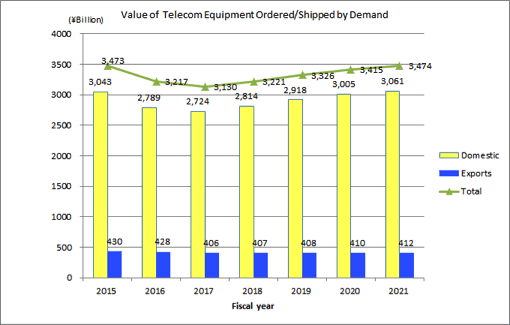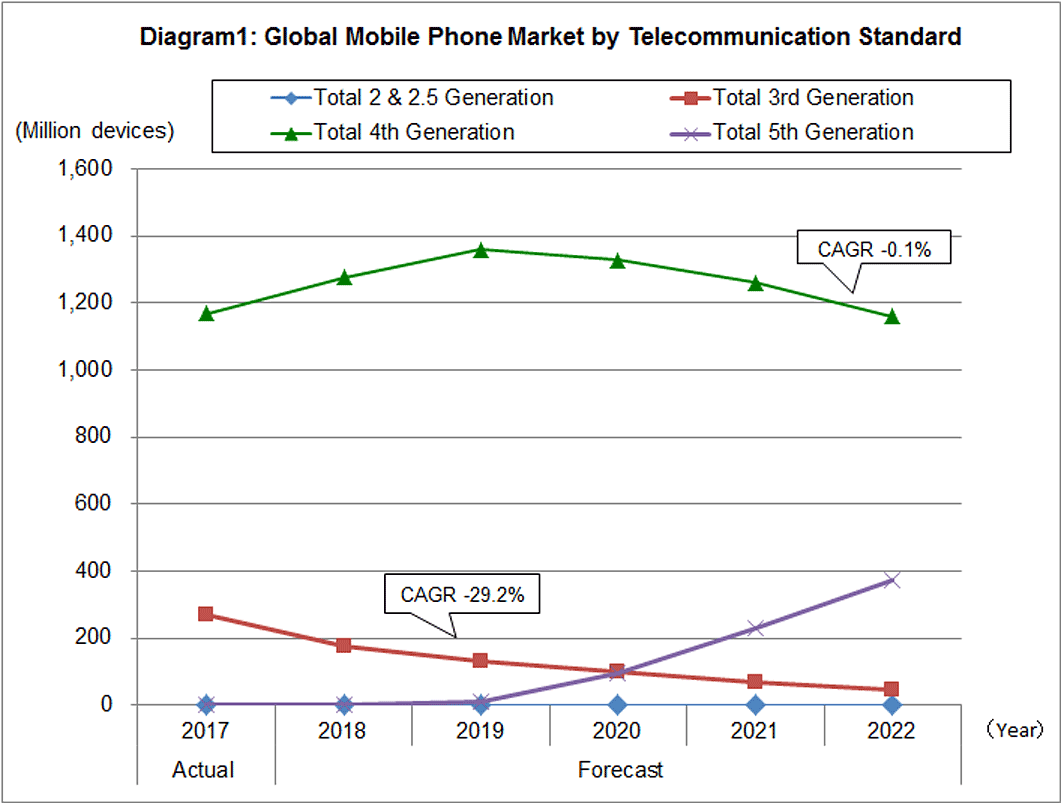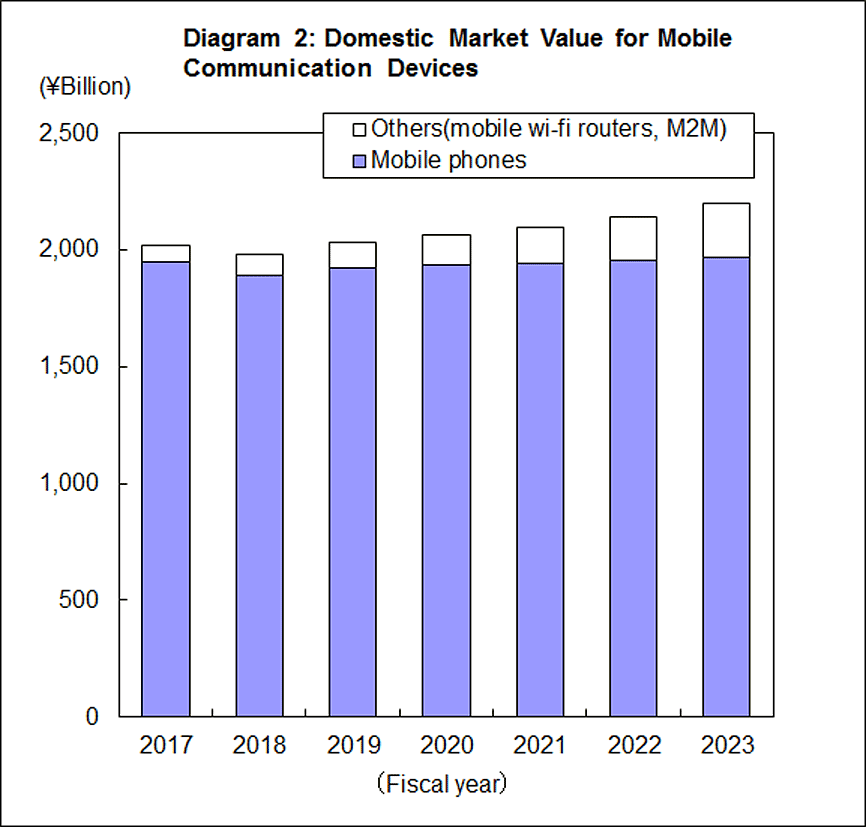The Communications and Information network Association of Japan (CIAJ), a general incorporated association, released its “Mid-Term Demand Forecast for Telecommunication Equipment,” covering FY2018 through FY2023. The forecast looks at technology trends and new demand creation for terminal devices and infrastructure equipment with fifth generation mobile communications technology (5G), artificial intelligence (AI) and the internet of things (IoT), all expected to play a vital role in bringing the Japanese government’s Society 5.0 to life.
The FY2018 telecommunication market is forecast to end in negative growth with longer replacement cycles of mobile devices, shrinking demand for home and office-use telephone sets with less use and lower investment in telecom infrastructure as 4G nears end-of-life before cutover to 5G, but momentum for 5G investment has yet to pick up.
From FY2019 onwards, the realization of Society 5.0, integrating new services and technologies such as IoT services, 5G smartphones, autonomous driving, robots and AI will bring about a more convenient and enriching lifestyle that encourages greater consumption and provides solutions to social issues, such as lower birthrate and shrinking labor force. Demand for telecom terminal devices and core network equipment that is part of society’s fundamental infrastructure is expected to gradually grow the domestic telecommunication market towards FY2023.
I. Outline
The Japanese economy in FY2017 continued a gradual recovery, with growth in consumer spending, including automobiles and mobile telephones. Business investments in telecom equipment decreased, but spending in manufacturing equipment picked up. Recovery of global economies contributed to the healthy export of electronic parts for automobiles and mobile phones, which all led to the third straight positive real GDP growth at 1.6% for FY2017. The telecommunication equipment market in FY2017 benefited from the timing of the 2-year mobile contract cycle that encourages replacement of phones. Combined with the demand growth in internet-related equipment from new data center investments, the recovery of global economies and related business-use demand pushing the value of exports higher all played a part in the approximately 3.638 trillion yen demand for telecom equipment (2.9% year-over-year growth).
The gradual recovery being experienced by the Japanese economy in FY2018 is slowing and real GDP is expected to be 1.0% (the average of figures announced by 9 private sector research institutions as of November). Longer replacement cycles translating into less demand for handsets, the market entering a transition period to 5G mobile technology pushing capital investments lower led to the CIAJ forecast for telecommunication equipment demand in FY2018 of 3.519 trillion yen or a negative year-over-year growth of 3.3%. By category, LAN switches and fixed communication equipment are forecast to have positive growth for the year.
From FY2019 onwards, the realization of Society 5.0 is expected to push the market into a period of demand growth with the total market value in FY2023 forecast to reach 3.821 trillion yen, an increase of 5.0% over the FY2017 figure The equipment categories forecast to record positive growth over FY2017 are mobile terminals, base station equipment, LAN switches and fixed communication equipment.
II. Actual Figures (Chapter 2)
The total telecommunication equipment market figure for FY2017 was approximately 3.638 trillion yen (+2.9% year-over-year growth), with the domestic market accounting for about 3.200 trillion yen (+2.4% year-over-year growth), and exports accounting for 438.1 billion yen (+6.7% year-over-year growth).
(1) Consumer equipment total: 2.113 trillion yen (+11.6% year-over-year growth)
The actual FY2017 figure for the global market of mobile phones (including smartphones) grew in yen value at 38.539 trillion yen (+2.9% year-over-year growth), but decreased to 343.487 billion in U.S. dollars (-0.3% year-over-year growth).
Despite the longer replacement cycles, 2017 was the end of the 2-year contract renewal cycle, contributing to the 2.232 trillion yen domestic FY2017 mobile terminal market value (aggregate of smartphones, feature phones, mobile wi-fi routers and M2M modules) (+12.6% year-over-year growth). Exports amounted to 34.0 billion yen (-15% year-over-year growth).
The FY2017 domestic figure for cordless phones, personal facsimiles and multi-functioning personal facsimiles was 27.2 billion yen (-9.6% year-over-year growth), while exports was 28.3 billion yen +9.8% year-over-year growth).
(2) Enterprise equipment total: 539.7 billion yen (+2.3% year-over-year growth)
Demand for key telephones, PBXs and office-use cordless telephones were mostly replacement. Together with the shrinking demand for fixed telephone services and decreasing voice traffic, combined with longer replacement cycles contributed to the FY2017 domestic figure of 70.4 billion yen (-10.1% year-over-year growth) and 20.0 billion yen (-36.5% year-over-year growth) export figure for the overall category.
The cycle for purchasing office-use facsimiles tapered off, leading to the FY2017 domestic figure of 190.7 billion yen (-7.7% year-over-year growth). The continuing shift to multi-functioning facsimiles continued, resulting in 258.5 billion yen (+22.5% year-over-year growth) in exports.
(3) Infrastructure equipment total: 526.1 billion yen (-19.7% year-over-year growth)
The decrease in capital investment by telecom carriers played a part in the FY2017 figure for fixed terrestrial communication equipment of 43.3 billion yen (-5.0% year-over-year growth). The tough competition over global market share has led to price wars, but the demand for backhaul systems for LTE/4G mobile services helped increase exports to 25.2 billion yen (+19.4% year-over-year growth).
Fruition of predicted demand for quasi-zenith satellites lifted the domestic FY2017 figure for fixed satellite communication equipment to 107.1 billion yen (+4.9% year-over-year growth), but the export figure was 5.8 billion yen (-31.0% year-over-year growth).
The migration of PSTN (Public Switched Telephone Network) to IP and the lull in capital investments before the transition to the new 5G network resulted in the FY2017 domestic figure for central office switching systems, fixed communication equipment and base station equipment of 320.4 billion yen (-28.6% year-over-year growth), and exports was 24.4 billion (-16.0% year-over-year growth).
(4) Internet equipment total for domestic market: 285.0 billion yen (-2.0% year-over-year growth)
Demand continued to grow for LAN switches from telecom carriers, as they tackled traffic growth, especially among developed countries, with the global market amounting to 270.7 billion yen (+4.9% year-over-year growth), or 2.413 billion U.S. dollars (+1.7% year-over-year growth). Demand for enterprise-use LAN switches also continues to grow as need to accommodate high-speed, large volume transmission mounts and trends such as IoT expand use-case scenarios. The global market amounted to approximately 2.798 trillion yen (+11.9% year-over-year growth), or 24.933 billion U.S. dollars (+8.5% year-over-year growth).
The domestic LAN switch market (carriers + enterprise) was 166.4 billion yen (+4.5% year-over-year growth). Increasing capacity to keep up with the surge in data traffic by telecom carriers and building new or expanding existing data centers to keep up with cloud service offerings continued to fuel demand. Exports, on the other hand recorded negative growth as Japanese brands had difficulty gaining a competitive edge in the global market.
In routers and optical access equipment, capital investment in optical fiber networks and measures to tackle mobile data traffic tapered off in FY2017 amounting to 118.6 billion yen (-9.6% year-over-year growth) for the domestic market. The value of exports was 400 million yen (-20.0% year-over-year growth)
(5) Equipment/parts categories not included above: 174.3 billion yen (+2.8% year-over-year growth)
III. Forecast Figures (Chapter 3)
[1] FY2018 Forecast
The total telecommunication equipment market figure for FY2018 is forecast at approximately 3.519 trillion yen (-3.3% year-over-year growth), with the domestic market accounting for 3.971 trillion yen (-3.2% year-over-year growth), and exports accounting for 421.8 billion yen (-3.7% year-over-year growth).
(1) Consumer equipment total: 2.665 trillion yen (-2.2% year-over-year growth)
The replacement cycle of mobile terminals continues to become longer, impacted by such factors as the scrutiny from a Ministry of Internal Affairs and Communications (MIC) task force over extreme discounts on terminals. The value of shipments for the domestic market in FY2018 is forecast to amount to 1.984 trillion yen, (-1.9% year-over growth), while exports decrease to 28.9 billion yen (-14.9% year-over growth). Frequency of use and replacement cycles continue to become fewer and longer for cordless phones and personal facsimiles and is reflected in the FY2018 domestic market figure of 25.4 billion yen (-6.8% year-over growth) and exports at 28.0 billion yen (-0.9% year-over growth).
(2) Enterprise equipment total: 503.7 billion yen (-6.7% year-over-year growth)
Replacements are central to demand for key telephones, PBXs and office-use cordless phones. The forecast for the FY2018 domestic market is 67.7 billion yen (-3.9% year-over growth), with exports amounting to 19.3 billion yen (-3.7% year-over growth). The migration from simple office-use facsimiles to multi-functioning facsimiles continues, with multi-functioning facsimiles making up the bulk of exports. The FY2018 domestic market is expected to decline to 184.4 billion yen (-3.3% year-over growth), while exports are forecast at 232.4 billion yen (-10.1% year-over growth).
(3) Infrastructure equipment total: 481.3 billion yen (-8.5% year-over-year growth)
The most recent domestic demand cycle for central office switching systems, digital transmission equipment, fixed communication equipment and base stations is expected to have slowed, with domestic market value in FY2018 expected to be 412.4 billion yen (-12.4% year-over growth). On the other hand, robust global economies are forecast to have increased overseas demand for base stations and fixed communication equipment, leading to exports reaching 68.9 billion yen (+24.4% year-over growth).
(4) Internet equipment total: 289.7 billion yen (+1.6% year-over-year growth)
Active investments in data centers is forecast to continue to sustain domestic demand for routers, LAN switches and optical access equipment, amounting to 289.7 billion yen (+1.6% year-over-year growth) in FY2018 and exports to be almost negligible.
(5) Equipment/parts categories not included above: 177.7 billion yen (+1.9% year-over-year growth)
[2] Midterm Projection
The FY2023total figure is projected at 3.821 trillion yen (+5.0% growth over FY2017), with the domestic market accounting for 3.398 trillion yen (+6.2% growth over FY2017) and exports accounting for 423.2 billion yen (-3.4% growth over FY2017).
(1) Consumer equipment total 2.257 trillion yen (+6.9% over FY2017)
The global mobile phone market (includes smartphones) is expected to grow with the launch of 5G services around 2019, with sales revenue in FY2022 projected at 380.5 billion U.S. dollars (CAGR 2.1% over FY2017). Commercial 5G service availability is expected to become widespread around 2020, with 5G-compatible devices accounting for 23.6% of all handsets sold in 2022.
The domestic market will continue to see even longer replacement cycles for mobile phones, and the government pressure to lower mobile carrier charges and the ensuing move to separate handset cost from communication charges from the latter half of FY2018 will dampen demand. However, Rakuten’s entry into the MNO market, and the ensuing marketing efforts by existing MNOs should stimulate the market together with new 5G models appearing in 2020 onwards. Altogether, the total value of the domestic market in FY2023 for mobile communication devices is projected at 2.199 trillion yen (+8.7% growth over FY2017), with exports at 12.9 billion yen (-62.1% growth over FY2017)
Although some concentrated demand for cordless phones and personal facsimiles among older adult households can be expected, overall demand is forecast to shrink. The total value of the domestic market in FY2023 is projected at 18.3 billion yen (-32.7% growth over FY2017), with exports at 26.8 billion yen (-5.3% growth over FY2017).
(2) Enterprise equipment total: 476.4 billion yen (-11.7% over FY2017)
In key telephones, PBXs and office-use cordless phones, new demand for BCP (business contingency plan) initiatives to secure communications during natural disasters, nurse call systems for nursing care facilities, multi-lingual services for accommodations targeting foreign tourists and shifts to lower energy consumption models will not be enough to overcome negative factors, which will include migration to cloud services and IP, as well as replacement by smartphones. The total value of the domestic market in FY2023 is projected at 57.0 billion yen (-19.0% growth over FY2017), with exports at 18.8 billion yen (-6.3% growth over FY2017).
Despite the surge in construction of accommodations and public facilities towards 2020, domestic demand for office-use facsimiles will shrink even further, as means of communications shifts to e-mail and other medium, frequency of use diminishes and replacement cycles become longer. All in all, the total value of the domestic market for office-use facsimiles in FY2023 is projected at 155.9 billion yen (-18.3% growth over FY2017). Although Japanese brands have a large share of the global multi-function facsimile market, tough price wars to compete with the second-hand market are reflected in the forecast for exports at 244.7 billion yen (-5.3% growth over FY2017).
(3) Infrastructure equipment total: 621.5 billion yen (+18.1% over FY2017)
Accommodating rise in mobile traffic with the launch of 5G, enhancements in domestic network speed to handle large-volume data such as 4K/8K contents, demand growth of data centers and ensuing capacity for massive amounts of data and emergency information systems necessary for natural disasters are projected to lead to significant demand growth for infrastructure equipment. The domestic market value of central office switching systems, digital transmission equipment, fixed communication equipment and base stations in 2023 is expected to reach 545.9 billion yen (+16.0% growth over FY2017) and exports are projected at 75.6 billion yen (+36.6% growth over FY2017).
(4) Internet equipment total: 300.9 billion yen (+5.6% over FY2017)
Investment in system infrastructure among emerging markets is expected to have a positive impact on global demand for routers, but increasing virtualization among developed countries and dropping unit prices have led to the projection of 2.717 billion U.S. dollars (CAGR -1.4%) for telecom carrier routers in FY2022. On the other hand, the global market for LAN switches targeting enterprise use is forecast to grow, not only to keep up with higher speeds and exploding data volumes, but to also accommodate IoT devices and cloud services, reflected in the forecast of 28.430 billion U.S. dollars (CAGR +2.6%).
In the domestic market for internet equipment, telecom carriers are expected to make further investments in their facilities to handle increasing mobile traffic from smartphones and widespread utilization of IoT, but the pressure to lower equipment and per port unit prices from aggressive competition, as well as advances in virtualization with standard hardware will push figures down. Altogether, the FY2023 projection for the domestic market value of routers, LAN switches and optical access equipment is projected to amount to 300.9 billion yen (+5.6% growth over FY2017).
(5) Equipment/parts categories not included above: 165.1 billion yen (-5.3% year-over-year growth)
IV. Trends in the Info-Communication Industry Market (Chapters 4)
The Chapter explains recent market trends in ICT solutions and value-added services. Section 1 covers advances in virtualization and distributed processing technologies, while section 3 covers new topics, such as the growing AR/VR contents and the popularity of the sharing economy.
Domestic market forecasts are based on statistics compiled by CIAJ and interviews with CIAJ members, with the cooperation of InfoCom Research, Incorporated, for areas not covered by CIAJ.
Global ICT market forecasts and demand trends refer to and utilize data and analysis provided by a global research company HIS Markit with the cooperation of InfoCom Research, Incorporated.
Please contact Mr. Nakai (e-mail: s_nakai[at]ciaj.or.jp) to purchase a copy of the CIAJ Mid-Term Demand Forecast for Telecommunication Equipment (2018 – 2023) (6,000 yen + tax for CIAJ members, 19,000 yen + tax for non-CIAJ members). The CIAJ Mid-Term Demand Forecast for Telecommunication Equipment is available in Japanese only.
For details, contact
Market Research
CIAJ
tel: 81-3-5403-9356 fax: 81-3-5403-9360
For more general inquiries, contact
Corporate Communications
CIAJ
tel: 81-3-5403-9351 fax: 81-3-5403-9360



